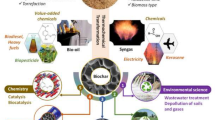Abstract
This article analyzes the production and diffusion of the scientific products of sixty-one researchers in soil sciences belonging to ORSTOM. In a period corresponding to two scientific generations we have observed important changes in writing and publishing habits. Non-published reports have lost importance while article production has grown. Also there is a noteworthy growth of the number of presentations at meetings, most of them international scientific congresses. The article shows the result of a factor analysis of their production that allows us to identify seven different types of behavior. We have stressed a series of elements explaining these different types. The possible predominance of a nationally oriented production behavior can be mainly explained by easy access to publication, sufficient appropriateness to the kind of data studied, and correct recognition by scientific peers. Finally we suggest that this typology can be used for analytical purposes in order to study the growth and publication patterns of Third World science.
Similar content being viewed by others
References
See B. BADIE,Le développment politique, Economica, Paris, 1980.
See two papers from Y. CHATELIN, G. RIOU, in:Pratiques et Politiques Scientifiques, Y. CHATELIN, R. ARVANITIS (Eds.), Editions de L'ORSTOM, Paris, 1984; 149–156, 171–181.
Bibliometric studies are generally conducted assuming that the domination of Northern countries versus Southern countries is the “normal” situation. In order to reassess this statement, see Y. CHATELIN, R. ARVANITIS,Stratégies scientifiques et Développment. Sols et Agriculture des Régions Chaudes, Editions de l'ORSTOM, Paris, 1988. See also M. ROCHE, Y. FREITES, Producción y flujo de informacion cientifica en un pais periférico americano (Venezuela),Interciencia, 7 (No 5) (1982) 279–290.
Y. CHATELIN, La Science et le Développement. L'Histoire peut-elle recommencer?,Revue Tiers-Monde, 27 (No 105) (1986) 5–24.
France is also one of the biggest producers on these topics. Australia, New Zealand, Israel, and South Africa produce 26% of the literature on tropical soils and agriculture and the Southern countries 51%. It is probable that France's position would be even higher if sole “pedology” was taken into account in this statistic. See R. ARVANITIS, Y. CHATELIN, National Scientific Strategies in Tropical Soil Sciences,Social Studies of Science, 18 (1988) 113–148.
On the theme of scientific institutions in the Third World, see H. VESSURI (Ed.),Siencia Académica en la Venezuela Moderna, Caracas: Fondo Editorial Acta Científica Venezolana, 1984, and H. VESSURI (Ed.),Las instituciones cientificas en la historia de la ciencia en Venezuela, Caracas: Fondo Editorial Acta Cientifica Venezolana, 1987; also SCHARTZMAN (Ed.),Universidades e Instituçoes cientificas no Rio de Janeiro, CNPq, Brasilia, 1982.
We extensively analyze the notion of “mainstream” research in: R. ARVANITIS, Y. CHATELIN, (1988), op. cit.. note 5.
Moreover, among Central countries, ORSTOM is unique in its functioning since its researchers live in the developing countries where they do the fildwork, so that they share partly the conditions of Peripheral scientists.
This corresponds to the mean age of the entire soil science community of the Institute as revealed by an internal study of a task force on the state of soil sciences in ORSTOM.
Co-authored articles were counted as one unit for each of the authors.
B. LATOUR, S. WOOLGAR,Laboratory Life, Sage Publications, Beverly Hills, 1979.
Reference in note 3: Y. CHATELIN, R. ARVANITIS, (1988), specially Chapter 4.
Excluding all non-conventional literature (1.6 for unpublished reports and 1.4 for working papers). As expected—since they represent mostly ideas developed in the long run by individual scientists—working papers show the lowest number of co-authors.
It is those countries that invented the modern “ethic” of science that follow it least. The most probable explanation lies in the fact that, in most of the Third World countries, scientists are encouraged to publish at an international level through the evaluation systems they adopt; this is also the conclusion of L. VELHO,Science on the periphery: a study of the agricultural scientific community in brazilian universities, PhD Thesis, SPRU, Sussex (G.B.), 1985, and of other studies on the institutionalization of research in Third World countries (see references in note 6).
For general principles of factor analysis, see J. P. BENZÈCRI,L'analyse des données, Dunod, Paris, 1973, Vol. 2, 616 and 620 pp. Our computations were made in CIRCE, the main computer center of “Centre National de la Recherche Scientifique” (CNRS) in Paris, applying programs fromYagolnitzer andTabet. For interpretation of this analysis, we used J. P. FENELON,Qu'est-ce que l'analyse des données?, Lefonen, Paris, 1981, 312 p. We received also personal help fromJ. P. Courtial, “Ecole Nationale des Mines”, Paris.
See notes 5 and 7. One has to understand that, relating to French scientists, the “mainstream” cannot be exactly what is defined by the Institute for Scientific Information.
Eisemon andDavis recently showed that this is a common contradiction in the behavior of most scientists. T. O. EISEMON, CH. DAVIS,Publication Strategies of Scientists in Four Peripheral Scientific Communities: Some Issues in the Measurement and Interpretation of Non-Mainstream Science, to be published in a book on academic research environments, P. ALTBACH (Ed.).
This challenges the view that growing scientific communities tend necessarily to be integrated in the international “mainstream”. For such a recent statement, see LOMNITZ, REES, CAMEO, Publication and Referencing Patterns in a Mexican Research Institute,Social Studies of Science, 17 (1987) 115.
Author information
Authors and Affiliations
Rights and permissions
About this article
Cite this article
Chatelin, Y., Arvanitis, R. Between centers and peripheries. Scientometrics 17, 437–452 (1989). https://doi.org/10.1007/BF02017464
Received:
Issue Date:
DOI: https://doi.org/10.1007/BF02017464




